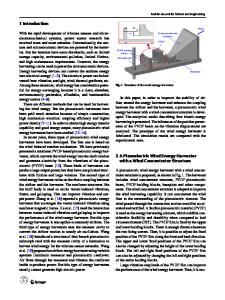Experimental demonstration of a dispersive spectral splitting concentrator for high efficiency photovoltaics
- PDF / 1,104,357 Bytes
- 7 Pages / 432 x 648 pts Page_size
- 54 Downloads / 253 Views
Experimental demonstration of a dispersive spectral splitting concentrator for high efficiency photovoltaics Carlo Maragliano1, Matteo Chiesa1 and Marco Stefancich2* Laboratory for Energy and NanoScience (LENS), Center for Future Energy Systems (iFES), Masdar Institute of Science and Technology, P.O. Box 54224, Abu Dhabi, UAE. 2 Istituto Materiali per l’Elettronica ed il Magnetismo, Consiglio Nazionale delle Ricerche, Parco Area delle Scienze 37/A - 43124 Parma, Italy 1
ABSTRACT We report the experimental demonstration of a low-cost paradigm for photovoltaic power generation that utilizes a prismatic Fresnel-like lens to simultaneously concentrate and separate sunlight into laterally spaced spectral bands. The optical element is designed using geometric optics and optical dispersion and its performance is simulated with a ray-tracing software. The device, fabricated by injection molding, suitable for large-scale mass production, is experimentally characterized. We report an average optical transmittance above 85% over the VIS-IR range and spectral separation in excellent agreement with our simulations. Finally, the system is tested with a pair of copper indium gallium selenide based solar cells. We demonstrate an increase in peak electrical power output of 160% under outdoor sunlight illumination, corresponding to an increase in power conversion efficiency of 15% relative to single-junction full-spectrum one-sun illumination. Given the ease of manufacturability and the potential of the proposed solution, we project that our design can provide a cost-effective alternative to multi-junction solar cells ready for mass production. INTRODUCTION The past decade has experienced impressive technological progress in photovoltaics (PV), with massive reductions in PV module costs that has resulted in solar energy to approach competitiveness with conventional fossil-fuel-based technologies[1]. A major market analysis identifies residential solar energy as having already reached grid parity in nearly 30 countries, with large regions of grid parity in several more[2]. Despite this success, the photovoltaic share in the world's electricity mix is still very modest[3] and it is far from reaching its potential to become a major source of energy in the near future. One of the greatest drawbacks is related to the low conversion efficiency of single junction solar cells, which in turn affect the cost of energy. The reason for this low efficiency is inherent to the cells limited spectral response: semiconducting materials absorb photons with energies greater than the band gap and, while photons with energy just above the band gap energy are efficiently converted, those with much larger energies are converted inefficiently due to hot carriers generation and those below band gap are completely lost. In the race to efficiently convert as much of the spectral extension of the sunlight as possible, multijunction (MJ) solar cells represent a valid alternative. MJ cells are constructed with different monocrystalline materials vertically stack
Data Loading...











